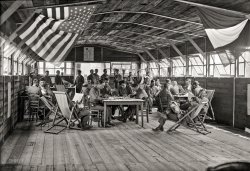
MAY CONTAIN NUTS

Search Shorpy
SHORPY ART

Framed or unframed, desk size to sofa size, printed by us in Arizona and Alabama since 2007. Explore now.
Join and Share
Ad-Free Shorpy
Shorpy is funded by you. Patreon contributors get an ad-free experience.
Learn more.

Recent comments
- Recent view
- Hudson’s Big Store
- Say what??
- Grapes?!
- A Beautiful Moment
- Such joy
- Bethune-Cookman University today...
- Yellow sky at morning
- Side Winder
- Air Quality?
- Sojourner Truth riot
- None were so blind(ed)
- The less famous sister
- Good ol' days?
- Rise and Fall
- Goo Goo Ga Joob
- Ticket Retention
- Not the only one
- Vagaries of War
- Killed by Amtrak
- Back to the Future
- Wanted --
- If you can't stand the light
- Centralized Traffic Control, I believe
- What's really happening
- Heckuva remote control!
- Sometimes — Things Go Bump!
- I SEE THE LIGHT
- Union Switch and Signal Company
- Get That Light Out Of My Eyes
Member Photos
The Shorpy
Print Emporium
Print Emporium
Search Shorpy
Search results -- 30 results per page
- Wyoming Baseball: 1910s
- ... clews The graffito directly to the man's left says "1912." (A proleptic message from the Class of, perhaps?)
I looked to see ... Posted by Dave - 11/26/2014 - 1:51pm -
![Wyoming Baseball: 1910s UPDATE: Our astute commenters reveal the location to be Wyoming Valley Seminary College in northeastern Pennsylvania.
"Wyoming baseball" is all it says on this 4x5 negative, from the same batch of glass plates as these college lads. The buildings are another clue. View full size.
Looking into the pastSince the two principal structures still exist this would be a perfect setting for this type of photograph. Any Shorpyites up to the job?
Wyoming Seminary, Kingston, PAHere's a Street View near where this photo was taken.
View Larger Map
View Larger Map
Wyoming Valley Seminary CollegeI am thinking this is taken at the Wyoming Valley Seminary College in northeastern Pennsylvania.
This Methodist seminary was founded in 1840.
(Edit: I notice that while I was posting my guess, kbostian was ahead of me by 2 minutes. Curses, foiled again.)
[More like 2½ hours, if you look at the time stamps. Although your comments were published simultaneously. -Dave]
(Edit: another thing I learned, when you edit your comments, the time stamp changes too.)
[Good point! -Dave]
Ripley Would Have Been ProudVenus de Milo in the window on the left and The Elephant Man in the window to her right.
Some clewsThe graffito directly to the man's left says "1912." (A proleptic message from the Class of, perhaps?)
I looked to see whether the building in the background matches any churches in Laramie. Although there are some with similar capped buttresses, I couldn't find a match.
[As it turns out (see below), Wyoming is in Pennsylvania. - Dave]
Not impressedAfter more than three years of being amazed by the historical and technical knowledge of the Shorpyites, coupled with their incredibly persistent detective work, I am unsatisfied with just knowing this is Wyoming Valley College.
I want to know the position played by the ballplayer, and whether he was right or left-handed.
The clock is ticking.
PS:
I cannot recall ever seeing trousers with a belt loop over the fly.
Night footballThe recent Wyoming Seminary postings especially caught my eye as I live in Mansfield, PA and Wyoming was Mansfield State Normal's opponent in the first American football game played at night in 1892.
The town, along with what is now Mansfield University, reenact the flying wedge style game as part of an annual 1890s themed weekend of activities.
(The Gallery, Found Photos, Sports)](https://www.shorpy.com/files/images/SHORPY-144-01.thumbnail.jpg)
- The Wilson: 1908
- ... today."
The Wilson: 1908 The Wilson burned down in 1912, and was replaced by a two-story block that still stands. I have written ... Posted by Dave - 04/22/2013 - 9:36am -
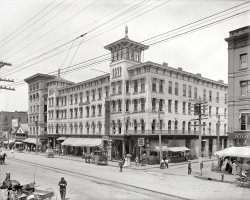
- Ruby, Alaska: 1915
- ... they had an unclaimed letter at the Ruby post office in 1912. Were they out mining on an area creek or had they moved on? In many cases ... Posted by Dave - 09/24/2009 - 9:06pm -
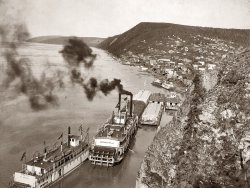
- Hotel Winston: 1913
- ... and sidelamps I tend to think this is an early 1913 or a 1912 with the accessory front doors added.
Eternal Imponderables Since ... Posted by Dave - 10/08/2014 - 1:23pm -
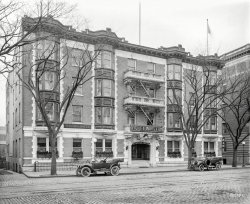
- Cozy Cottage: 1910s
- From 1912 or later comes "elderly man in rocking chair," watching the world go by ... Posted by Dave - 11/15/2014 - 8:56pm -
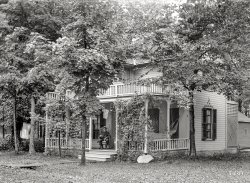
- Angelo Fusco
- ... around October 10th or 11th, arrival in NY on October 24, 1912. And from 1912 lived in New York until 1918.
Wouldn't it be something... ... Posted by angelofusco - 02/16/2008 - 10:29am -
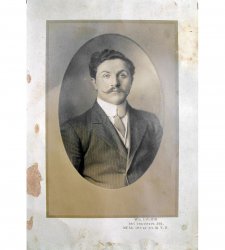
- Fields Landing
- ... as the whalers inn. Postmark on this post card is dated 1912.
Fields Landing Great to see this picture. I grew up there. I can see the house where I grew up in this 1912 pic. I remember the whaling station! Talk about smell! When a whaling ... Posted by kevhum - 05/15/2007 - 11:55pm -
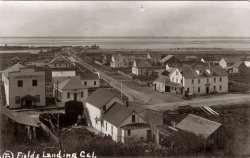
- Inside Track: 1943
- ... Warehouse, which was built in 1894 with an addition in 1912.
Not So Pleasant Street About two blocks west of JellyBelly's ... Posted by Dave - 03/17/2014 - 6:46pm -
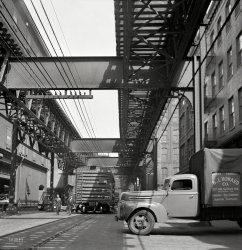
- Standard Equipment: 1920
- ... Mountains"), manufactured in Butler, Pennsylvania, from 1912 to 1923, was a product of the Standard Steel Car Company, maker of ... Posted by Dave - 01/23/2017 - 9:54pm -
![Standard Equipment: 1920 There is something about the snug click of the door latch and the clean, windless interior of a closed car that makes you feel at home and comfortable in there. The deep-cushioned seats, the curtains, the glass, the conversation in low tones -- all these things make getting somewhere as pleasant as being there. Getting home is never a problem, and the weather is but an incident. In the Standard Eight Coupe, Sedan or Sedanette, the powerful motor carries the extra burden of a closed body with an effortless ease ...
-- "People Don't Regret Buying Closed Cars" (Ad from 1921)
San Francisco circa 1920. "Standard Eight sedan at Golden Gate Park." The Standard ("Monarch of the Mountains"), manufactured in Butler, Pennsylvania, from 1912 to 1923, was a product of the Standard Steel Car Company, maker of railroad rolling stock. 5x7 glass negative by Christopher Helin. View full size.
A Very Nice Exampleof "Perpendicular Period" styling.
[Early Perpendicular. - Dave]
Like Sliced BreadIt's amazing to think that enclosed automobiles came later, even though enclosed carriages had been around for centuries. I have to assume it was a cost issue. Or maybe weight?
No regretsYou had me at door latch.
The old lady in backShe can remember covered wagons! I often wonder what the 20th century seemed like for people born in the 1830's and 1840's who lived long enough to see all the modern advancements. My mother's grandmother died at 96 in 1927, still living by herself in a gaslit house where she cooked every meal from scratch on a wood stove.
"Conversation in low tones"Really a lost art.
Closed carsThey were always available, as soon as cars of sufficient size began to replace motorized buggies.
Riding in a dry place with no wind was always a strong attraction, but closed cars faced a whole list of barriers that did not really break down until the later 1920s.
Almost all early bodies were framed in wood with elaborate joints and much bracing to keep doors functional and joints tight through the racking of driving on mostly bad roads.
This the bodies (especially four doors) substantially more expensive than roadsters and touring cars. Also, this type of construction deteriorated rapidly except perhaps in cars used only on city streets, and they soon succumbed to sagging doors, leaks, and general debilitation while their open bodied brothers were still functional.
Safety was also a major concern. Safety glass was still in the future, and the worst and commonest closed car crash injuries were caused by big, razor sharp chunks of plate glass flying around, often causing catastrophic bleeding.
Changeover to stamped steel construction moved rapidly in the later 1920's and rapidly reduced costs and improved rigidity and durability. Small scale uses of various types of safety glass came along, and at the end of the decade Ford moved to safety glass (driven by glass injuries to a Ford manager, I think) windshields and then as rapidly as production volume caught up to full use of safety glass. Just from observation I would say that our auto fleet moved to a very strong domination by closed cars in maybe 5 years, say 1925-1930.
By the way, all those failing wood framed sedans I mentioned had their bodies cut away and became the home-made open trucks preferred by all the folks in Shorpy pictures of migrating Okies.
[Mass-produced all-steel bodies made their debut in the mid-1930s, starting with General Motors' "Turret Top" cars of 1935. Up until then, roofs on closed cars were generally made of rubberized fabric stretched over a wooden frame. - Dave]
(The Gallery, Cars, Trucks, Buses, Chris Helin, San Francisco)](https://www.shorpy.com/files/images/SHORPY-1081.thumbnail.jpg)
- Warren Kealoha: 1924
- ... 100m Freestyle title he won at the previous Olympics... in 1912. The 1924 team also featured Duke Kahanamoku, his younger brother Samuel ... Posted by Dave - 09/04/2012 - 12:04pm -
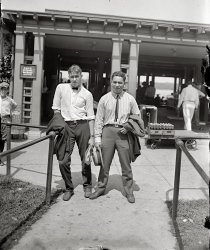
- Battle Wagon: 1921
- ... ambulance in 1906, and their first hearse automobile in 1912. Their only passenger car seems to be the Sayers Six in the picture, built ... Posted by Dave - 01/19/2019 - 10:12am -
![Battle Wagon: 1921 San Francisco circa 1921. "Sheridan touring car at Palace of Fine Arts." A product of the Sheridan Motor Car Co. of Muncie, Indiana, one of the more obscure entries in the Shorpy Catalog of Discontinued Conveyances. And evidently the buggy of choice for Civil War reenactors. Glass negative by Chris Helin. View full size.
Nothing Up His Sleeve It appears the Veteran Has an empty right sleeve.
[Except for the white thing coming out the end, which is his arm. - Dave]
Not Dead YetSayers and Scovill still exist as S&S Coach Company, outfitters of hearses and funeral limousines. They started building horse-drawn buggies, commercial wagons and funeral vehicles in 1876. They built the first motorized ambulance in 1906, and their first hearse automobile in 1912. Their only passenger car seems to be the Sayers Six in the picture, built from 1914 through 1924, with annual output rarely more than 200 per year. After that, they specialized in funeral vehicles. Although the company was sold several times, the brand remains active today.
The real thingI expect that the standup passenger is not re-enacting anything, but is a veteran of the conflict. The last veteran died about 35 years after the date of this picture, so having a live veteran was not unusual at the time.
[The fiftyish fellow with the spirit-gummed mustache isn't old enough. Below, actual Civil War veterans at Gettysburg in 1913. - Dave]
With Six You Get BedrollI've lived in Cincinnati many decades, but the Sayers Six is a new one on me. Avondale was one of Cincinnati's plushest neighborhoods in the Twenties, so that was likely the source of the car's model name.
(The Gallery, Cars, Trucks, Buses, Chris Helin, Civil War, San Francisco)](https://www.shorpy.com/files/images/SHORPY-318-02.thumbnail.jpg)
- Fenders Fixed: 1920
- ... fact hosting Studebaker in San Francisco for two weeks in 1912. Weaver was the head of the Studebaker Corporation of America, San ... Posted by Dave - 04/27/2016 - 1:55pm -
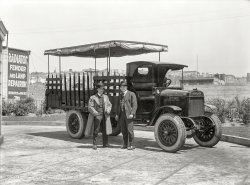
- Nicollet Avenue: 1904
- ... that building was constructed in 1890. The occupant in 1912 was the Minneapolis Dry Goods Company. In 1934 the tenant was the Leader ... Posted by Dave - 11/10/2017 - 6:41am -
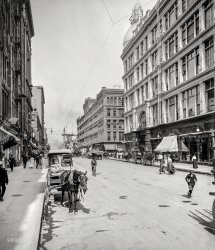
- Grand Rapids: 1908
- ... at 188 Monroe Street NW.
Canal was renamed Monroe in 1912. So the current description of the view would be Monroe Street north from ... Posted by Dave - 05/17/2014 - 11:34pm -
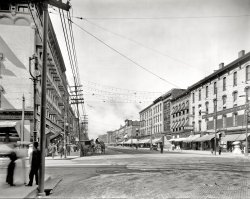
- Tete-a-Tete: 1914
- ... of the era. He spent several weeks during the summer of 1912 on the Rosebud Indian reservation in South Dakota looking for models for ... Posted by Dave - 08/28/2012 - 10:16pm -
![Tete-a-Tete: 1914 Washington, D.C., 1914. "Frank Mischa, sculptor." Co-star in a sort of meta-diorama. Harris & Ewing Collection glass negative. View full size.
Who blinked first?My money is on the sculpture.
Focus -- That's not a staring contest you're ever going to win.
Sculpted from lifeHere's another picture of Frank sculpting an African American child.
Lifecast portraitThe extreme lifelike quality of the skin texture indicates these were almost certainly made by molding directly on the model's skin using plaster or other molding materials. Also the fact that 90 of these finely detailed works were created in short order for an exhibition adds to the likelihood they were cast from life. In lifecasting the front part of the head, including face and neck, are molded, and then the back of the head and hair are recreated, either directly in plaster, or modeled in clay and then the entire composite portrait is molded again and cast in plaster.
Frank Micka, PreparatorThe artist pictured here was also known as Frank Micka. In 1914 he was an assistant to William H. Egberts, the first exhibitions preparator in the physical anthropology department of the National Museum, as the Smithsonian Institution's Natural History Museum was then called.
The exhibitions department created 90 of these plaster portrait busts of tribal peoples from around the world, for Dr. Ales Hrdlicka's physical anthropology exhibit at the 1915 Panama-California Exposition in San Diego. Titled "The Story of Man through the Ages," and displayed in the "Science of Man" exhibit hall, these hyper-lifelike portrait busts were a tremendous popular success, and helped to build support for the founding in 1917 of the San Diego Museum of Man, now an official affiliate of the Smithsonian Institutions.
In the National Museum's annual report for the year ending June 30, 1914, Micka was credited with finishing and painting the sculptures, and also with fabricating their exhibition cases. Despite his obvious skill and sensitivities, he does not seem to have had any other artistic career, and his name appears in none of the usual indexes of American sculptors.
[The Washington Post refers to him as a "New York sculptor," also as a private in the medical corps of the District National Guard. He is also mentioned a few times (as Frank Mischa) in periodicals of the era. He spent several weeks during the summer of 1912 on the Rosebud Indian reservation in South Dakota looking for models for his marbls busts. Micka and an actor friend, according to the Post, bribed a brave "to visit for several days while he made a study of the characteristics of the young Sioux." - Dave]
Master Plaster CasterThis is how Frank would have made this masterful sculpture:
1. He makes an original from clay.
2. He slops a coat of plaster around the clay to create a mold, using metal strips to create two separate halves.
3. The halves are pried off the clay original and rejoined.
4. Plaster is poured or swirled into the empty mold.
5. The mold is once again removed, leaving a plaster replica of the original clay.
(The Gallery, D.C., Harris + Ewing)](https://www.shorpy.com/files/images/04701a.thumbnail.jpg)
- The Silent Army: 1925
- ... watch: masts for the Navy's wireless station, built in 1912 at Fort Myer. View full size.
Notice the spurs "Black Jack ... Posted by Dave - 05/25/2015 - 2:26pm -
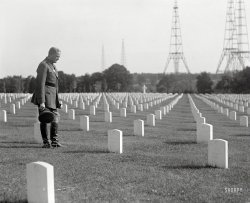
- Elizabeth Susan Baker
- ... Ohio. The picture was taken in Sandusky Fremont Ohio about 1912.
Alive! There's a vibrancy to this photo that makes the gorgeous ... focus, etc. Just my take on it. Looks more like 1972 than 1912.
(ShorpyBlog, Member Gallery) ... Posted by Larry3952 - 09/18/2015 - 7:04pm -

- War Camp: 1918
- ... New Mexico and Arizona, (47 & 48th) were admitted in 1912.
Victrola from 1915 or later According to the Victor-Victrola page ... Posted by Dave - 08/14/2008 - 2:10am -
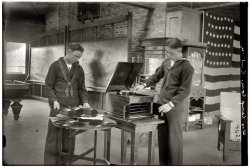
- Class Day: 1906
- ... is not there (the subway came to Harvard Square in 1912 and terminated there for over 70 years.) What a great photo; it brings ... Posted by Dave - 04/09/2015 - 10:17am -
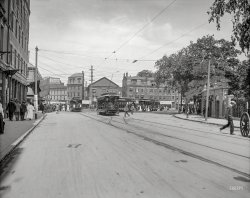
- Washington Market: 1812-1912
- New York, 1912. "Washington Market Centennial. With outside sheds removed by President ... Posted by Dave - 09/08/2011 - 11:02am -
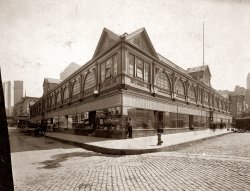
- Murphy's Hotel: 1905
- ... by a skywalk . Those buildings were torn down in 1912 and replaced with a new Murphy's Hotel, which was demolished in 2007 . ... Posted by Dave - 08/04/2018 - 4:59pm -
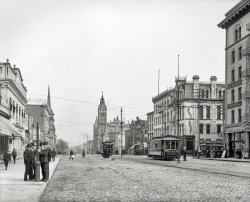
- Epiphany: 1920
- ... construction of a new building in 1902 and additions in 1912, the complex filled much of the block and soon ranked as Washington's ... Posted by Dave - 09/21/2015 - 6:03pm -
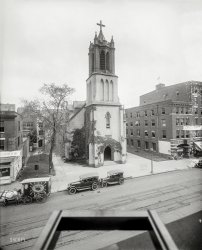
- Base Ball To-Day: 1908
- ... is the same down to the "Baseball To-day" sign. Date is 1912.
Credit to Detroit's Street Railways, by Kenneth Schramm.
(The ... Posted by Dave - 12/09/2018 - 7:40pm -
![Base Ball To-Day: 1908 Detroit circa 1908. "Woodward Avenue looking north from Opera House corner." Our title is lifted from the streetcar. 8x10 inch glass negative. View full size.
Not Much Left, Except ...The distinctive arched upper windows of the Elliott Building, built in 1894 and home for decades to the S.S. Kresge store, are a dead giveaway for the handsome building back to to the left. Now home to pricey condos and spacious urban apartments. And today, Base Ball is one word and you would not need the streetcar. It's played close by at Comerica Park, just four blocks away by foot.
Bumpy roadOn the left is Fred Sanders' Pavilion of Sweets. Sanders is an institution in Detroit, known for its candy, hot fudge and cream puffs. Although their claim as the inventor of the ice cream soda is unlikely, they did invent the Bumpy Cake - chocolate cake with buttercream ridges, covered in chocolate ganache.
Ty Cobb led the league in several categories that year. Doubles, triples, RBI's, insolent people slapped ...
Moon Tower?Is that moon tower in the background one of the thirty one that was purchased by Austin and still stand at Zilker and parts of the downtown?
[It's a moonlight tower. - Dave]
& BlackwellIt's possible that this photo is slightly misdated. All the way to the left you can see the end of a sign for the Pardridge & Blackwell department store. Near the end of 1906 though, Pardridge & Blackwell moved into their brand new store building a block east of this scene. Unfortunately, they soon ran into significant financial trouble and were forced to go out of business and give up that store to new owners, Crowley, Milner & Co. "Crowley's" would remain a core part of downtown Detroit for the next 70 years.
Art Not So NouveauBy 1908 that Art Nouveau script in the Wright Kay Jewelers sign on the far right would have been getting a little passe. I'm impressed by the width of the sidewalks! They are roads on their own! And I feel sorry for the two ladies crossing right to left from the corner in front of the Wright Kay Jeweler as they are having to navigate some "deposits" left by the horses while wearing those long skirts. Women of the time must have had to deal with stained and dusty clothes quite a bit, I suppose! No doubt they were relieved when the horses were phased out over the coming 10 years. I often forget how dirty (and foul smelling) cities were at the time.
Trolley signI have a book on the Detroit Street Railway system, and in it is a picture of a very similar trolley. The only difference is the destination sign, in this case it is "Third". Otherwise, it is the same down to the "Baseball To-day" sign. Date is 1912.
Credit to Detroit's Street Railways, by Kenneth Schramm.
(The Gallery, Detroit Photos, Streetcars)](https://www.shorpy.com/files/images/SHORPY-4a17898a.thumbnail.jpg)
- Chickering Hall: 1906
- ... to Charles Wesley Emerson's School of Oratory.
In 1912 it became the St. James Theater, and then finally the Uptown Theater. The ... Posted by Dave - 09/06/2012 - 1:46pm -
![Chickering Hall: 1906 Boston circa 1906. "Chickering Hall, Tremont Street." The grande dame of Piano Row. 8x10 inch glass negative, Detroit Publishing Company. View full size.
Ossip GabrilowitschNow there's a subject line for you. Gabrilowitsch was a renowned 20th century piano virtuoso, and performed in concert in Chickering Hall in March 1903. Earlier this year I unexpectedly came across his grave in Elmira, New York, while visiting that of Mark Twain, who was his father-in-law. How's that for degrees of separation? At the same cemetery, I also discovered the last resting place of movie producer Hal Roach, the guy who joined Laurel to Hardy. So there's another one.
Steinway's InspirationThe Chickering Logo is on the window here.
Here's Glenn Gould playing a Chickering.
Piano RowBeing a big Fred Allen fan, this picture caught my eye. Before Fred (John Florence Sullivan) became the famous radio star, he worked for a time at the Colonial Piano Co. It was located on Boylston Street. According to Fred, it was the first piano store in "Piano Row" coming from Tremont Street. He tells some amusing stories about this store and the whole area in his autobiography. I wonder if there are any existing photos of the Colonial store?
I've really enjoyed this site. I just joined a month or so ago and have finally viewed all the photos. I look forward each day for the next installment. Keep up the good work and hopefully I'll find something here at home that will be worthy for inclusion some day soon.
Location, location, location?The first Chickering Hall auditorium (circa 1883) was on Piano Row on Tremont Street near West St.
Our subject building, the second Chickering Hall, was completed in 1901 at 239 Huntington Ave in the Back Bay section. Sorry I missed the opening perfomance featuring Antoinette Szumowska, Pol Plançon, and the unforgetable Franz Kneisel Quartet. The theater was also home to Charles Wesley Emerson's School of Oratory.
In 1912 it became the St. James Theater, and then finally the Uptown Theater. The wrecking ball took its toll in 1963 when the Christian Science Center was built.
The rather ornate structure at left is Horticultural Hall also built in 1901. Location: corner of Mass. Ave.
Even olderThere was a Chickering Hall even before 1883. Ralph Waldo Emerson gave a series of readings there in 1869.
[Officially, though, that was called Chickering's Hall. - tterrace]
(The Gallery, Boston, DPC)](https://www.shorpy.com/files/images/SHORPY_4a11359a1.thumbnail.jpg)
- Den of Vice: 1900
- ... shooting death of Ruth Merwin by Stevenson, in December of 1912.
(The Gallery, DPC, Politics) ... Posted by Dave - 07/07/2016 - 1:31pm -
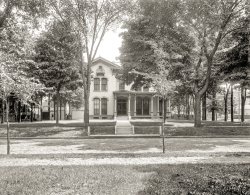
- Machine Shop
- ... continued this method as the patent must have run out by 1912. The Intertype spring pressure is released by simply unscrewing a rod ... Posted by John.Debold - 09/21/2011 - 9:15pm -
![Machine Shop On close inspection, I see a McKinley political sign. So would that be just before the turn of the century? View full size.
"Machine shop"These are linotype operators in a newspaper pressroom.
1896The 45-star flag became official 4 July 1896. Thomas Reed also ran for President in 1896 (losing the nomination to McKinley). The 1896 Republican convention was in June, I would guess flag makers (and the linotype shop) got an early jump on the new flags.
[The flag in the photo has 44 stars, not 45. - Dave]
LinotypeIn the 1950s my Uncle George Percy Gaskill of Barnegat, New Jersey, was the plant manager for Sleeper Publications in Mount Holly. I visited several times to observe his operation of the Linotype there. It was used to cast molten lead into "slugs," one for each line of type ("linotype")in a newspaper column. I have a couple of inserts that he made for me with my name.
Thomas ReedI was curious why this shop displayed both primary candidates, which led me to wikipedia. But I was soon distracted on the political story when I saw this about Thomas Reed...
He was known for his acerbic wit (asked if his party might nominate him for President, he noted "They could do worse, and they probably will"; asked if he would attend the funeral of a political opponent, his response was "no — but I approve of it"). On another occasion, when a fellow congressmen declared that he would "rather be right than the president," Reed coolly replied that the congressman needn't worry, since he would never be either. His size -- over 6 feet in height and weight over 300 pounds -- was also a distinguishing factor. Reed was a member of the social circle that included intellectuals and politicians Sen. Henry Cabot Lodge, Theodore Roosevelt, Henry Adams, John Hay and Mark Twain.
Interesting and funny man with some notable acquaintances.
[Reed and McKinley weren't "primary candidates" -- state presidential preference primaries didn't exist in 1896. The two were contenders for the Republican nomination at the party's national convention. - Dave]
IntertypeIf you look at the man on the left, closest to the camera, just to left of his head is a shaft inside a large spring. This indicates the these machines were Intertypes a typesetting machine very similar and in someways superior to the Linotype. How do I know? I spent my apprenticeship operating linotypes, and later in Australia spent some time on Intertypes. The shaft was attached to a plunger that pumped molten typemetal that cast the lines of type or slugs.That machine room would have been very noisy!
Linotypes, not Intertypes.Sorry, these can't be Intertypes, as the first Intertypes weren't in production until 1917.
Both Linotypes (some models, some years) and Intertypes had the vertically mounted spring for the pot plunger, it wasn't until much later that Lintotype moved that spring into the column. The actuation was slightly different as ll, as you can see on my 1922 Intertype.
From here:
"Original pot plunger spring on Linotype Model I was positioned directly above plunger lever to exert a straight downward action. Intertype continued this method as the patent must have run out by 1912. The Intertype spring pressure is released by simply unscrewing a rod straight up. Linotype "improved" their machine by a system of levers to put this spring inside the column. This worked until a stronger spring was necessary to cast larger slugs and improve faces for reproduction proofs. I remember a time in Santa Rosa, California, when it was a three-man job to put that heavy spring back in place on a Model 8 Linotype."
etaoin shrdlu cmfwyp vbgkqj xz
(ShorpyBlog, Member Gallery)](https://www.shorpy.com/files/images/Desoto0002.thumbnail.jpg)
- Signals: 1920
- ... Two superheated prototypes were built by the Pennsy in 1912, one (#1092, class E6sa) with rotary valves and smaller cylinders. ... Posted by Dave - 09/11/2011 - 7:22pm -
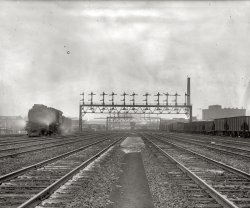
- Flour Power: 1911
- ... to divest these steamship lines by the Panama Canal Act of 1912. Aside from their builder and similar service, both vessels shared a ... Posted by Dave - 08/06/2014 - 10:50am -
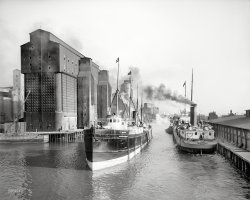
- Grant Park: 1911
- ... in the cleared space to its right, was completed in 1912. The whole building was converted to condominiums several years ago. With ... Posted by Dave - 08/07/2014 - 5:17pm -
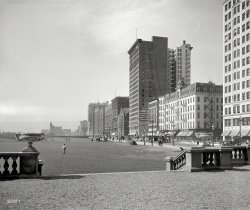
- Croix Rouge Americaine: 1919
- ... staggered 48 flag was produced in pretty fair numbers from 1912 at least up through the end of World War I. My grandfather came home from ... Posted by Dave - 07/02/2017 - 6:12pm -
